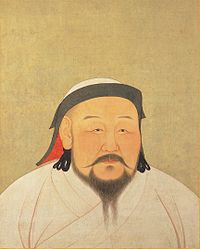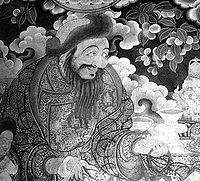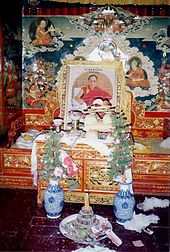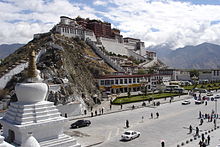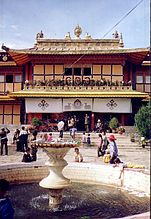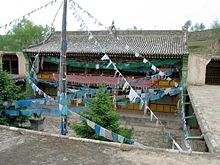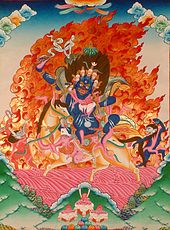
Dalai Lama
Background to the schools Wikipedia
This Wikipedia selection is available offline from SOS Children for distribution in the developing world. SOS Child sponsorship is cool!
| Dalai Lama | |
|---|---|
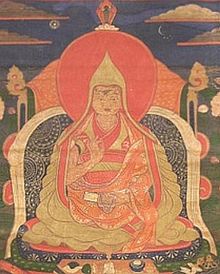 Gendun Drup, 1st Dalai Lama |
|
| Reign | 1391–1474 |
| Tibetan | ཏཱ་ལའི་བླ་མ་ |
| Wylie transliteration | taa la'i bla ma |
| Pronunciation | [taːlɛː lama] |
| THDL | Dalai Lama |
| Royal House | Dalai Lama / atakaten |
The Dalai Lama is a high lama in the Gelug or "Yellow Hat" school of Tibetan Buddhism, founded by Tsongkhapa (1357–1419). The name is a combination of the Mongolian word dalai meaning "Ocean" and the Tibetan word བླ་མ་ bla-ma (with a silent "b") meaning "guru, teacher".
According to Tibetan Buddhist doctrine, the Dalai Lama is the rebirth in a line of tulkus who are metaphorically considered to be manifestations of the bodhisattva of compassion, Avalokiteśvara. The Dalai Lama is often thought to be the leader of the Gelug School, but this position belongs officially to the Ganden Tripa, which is a temporary position appointed by the Dalai Lama who, in practice, exerts much influence. The line of Dalai Lamas began as a lineage of spiritual teachers; the 5th Dalai Lama assumed political authority over Tibet.
For certain periods between the 17th century and 1959, the Dalai Lamas sometimes directed the Tibetan government, which administered portions of Tibet from Lhasa. The 14th Dalai Lama remained the head of state for the Central Tibetan Administration ("Tibetan government in exile") until his retirement on March 14, 2011. He has indicated that the institution of the Dalai Lama may be abolished in the future, and also that the next Dalai Lama may be found outside Tibet and may be female. The Chinese government rejected this and asserted that only it has the authority to select the next Dalai Lama.
The original use of the name Dalai Lama
In 1578 the Mongol ruler Altan Khan bestowed the title Dalai Lama on Sonam Gyatso. The title was later applied retroactively to the two predecessors in his reincarnation line, Gendun Drup and Gendun Gyatso. Gendun Gyatso was also Sonam Gyatso's predecessor as abbot of Drepung monastery. However, the 14th Dalai Lama asserts that Altan Khan did not intend to bestow a title as such and that he intended only to translate the name "Sonam Gyatso" into Mongolian.
... many writers have mistranslated Dalai Lama as "Ocean of Wisdom". The full Mongolian title, "the wonderful Vajradhara, good splendid meritorious ocean", given by Altan Khan, is primarily a translation of the Tibetan words Sonam Gyatso (sonam is "merit").
The 14th Dalai Lama commented:
The very name of each Dalai Lama from the Second Dalai Lama onwards had the word Gyatso [in it], which means "ocean" in Tibetan. Even now I am Tenzin Gyatso, so the first name is changing but the second part [the word "ocean"] became like part of each Dalai Lama's name. All of the Dalai Lamas, since the Second, have this name. So I don't really agree that the Mongols actually conferred a title. It was just a translation.

Whatever the intention may have been originally, the Mongolian "Dalai", which does not have any meaning as a Tibetan term, came to be understood commonly as a title.
The name or title Dalai Lama in Mongolian may also have derived originally from the title taken by Temüjin or Genghis Khan when he was proclaimed emperor of a united Mongolia during 1206. Temüjin took the name Čingis Qāghan or "oceanic sovereign", the anglicized version of which is Genghis Khan.
Tibetans address the Dalai Lama as Gyalwa Rinpoche ("Precious Victor"), Kundun ("Presence"), Yishin Norbu (" Wish fulfilling Gem") and so on.
Sonam Gyatso was an abbot at the Drepung Monastery who was considered widely as one of the most eminent lamas of his time. Although Sonam Gyatso became the first lama to have the title "Dalai Lama" as described above, since he was the third member of his lineage, he became known as the "Third Dalai Lama". The previous two titles were conferred posthumously upon his supposed earlier incarnations.
Yonten Gyatso (1589–1616), the 4th Dalai Lama, and a non-Tibetan, was the grandson of Altan Khan.
The tulku tradition of the Dalai Lama has evolved into, and been inaugurated as, an institution:
The institution of the Dalai Lama has become, over the centuries, a central focus of Tibetan cultural identity; "a symbolic embodiment of the Tibetan national character." Today, the Dalai Lama and the office of the Dalai Lama have become focal points in their struggle towards independence and, more urgently, cultural survival. The Dalai Lama is regarded as the principal incarnation of Chenrezig (referred to as Avalokiteshvara in India), the bodhisattva of compassion and patron deity of Tibet. In that role, the Dalai Lama has chosen to use peace and compassion in his treatment of his own people and his oppressors. In this sense the Dalai Lama is the embodiment of an ideal of Tibetan values and a cornerstone of Tibetan identity and culture.
Verhaegen mentions the trans- polity influence that the Institution of the Dalai Lama has had historically in areas such as western China, Mongolia, Ladakh in addition to the other Himalayan Kingdoms:
The Dalai Lamas have also functioned as the principal spiritual guide to many Himalayan kingdoms bordering Tibet, as well as western China, Mongolia and Ladakh. The literary works of the Dalai Lamas have, over the centuries, inspired more than fifty million people in these regions. Those writings, reflecting the fusion of Buddhist philosophy embodied in Tibetan Buddhism, have become one of the world's great repositories of spiritual thought.
The current Dalai Lama is often called " His Holiness" (HH) by Westerners (by analogy with the Pope), although this does not translate to a Tibetan title.
Before the 20th century, European sources often referred to the Dalai Lama as the "Grand Lama". For example, in 1785 Benjamin Franklin Bache mocked George Washington by terming him the "Grand Lama of this Country". Some in the West believed the Dalai Lama to be worshipped by the Tibetans as the godhead.
History
During 1252, Kublai Khan granted an audience to Drogön Chögyal Phagpa and Karma Pakshi, the 2nd Karmapa. Karma Pakshi, however, sought the patronage of Möngke Khan. Before his death in 1283, Karma Pakshi wrote a will to protect the established interests of his sect by advising his disciples to locate a boy to inherit the black hat. His instruction was based on the premise that Buddhist ideology is eternal, and that Buddha would send emanations to complete the missions he had initiated. Karma Pakshi's disciples acted in accordance with the will and located the reincarnated boy of their master. The event was the beginning of the teacher reincarnation system for the Black-Hat Line of Tibetan Buddhism. During the Ming Dynasty, the Yongle Emperor bestowed the title Great Treasure Prince of Dharma, the first of the three Princes of Dharma, upon the Black-Hat Karmapa. Various sects of Tibetan Buddhism responded to the teacher reincarnation system by creating similar lineages.
Unification of Tibet
In the 1630s, Tibet became entangled in power struggles between the rising Manchu and various Mongol and Oirat factions. Ligden Khan of the Chakhar, retreating from the Manchu, set out to Tibet to destroy the Yellow Hat sect. He died on the way to Qinghai (Koko Nur) in 1634. His vassal Tsogt Taij continued the fight, even having his own son Arslan killed after Arslan changed sides. Tsogt Taij was defeated and killed by Güshi Khan of the Khoshud in 1637, who would in turn become the overlord of Tibet, and act as a "Protector of the Yellow Church." Güshi helped the Fifth Dalai Lama to establish himself as the highest spiritual and political authority in Tibet and destroyed any potential rivals. The time of the Fifth Dalai Lama was, however, also a period of rich cultural development.
The Fifth Dalai Lama's death was kept secret for fifteen years by the regent ( Tibetan: སྡེ་སྲིད།, Wylie: sde-srid), Sanggye Gyatso. This was apparently done so that the Potala Palace could be finished, and to prevent Tibet's neighbors taking advantage of an interregnum in the succession of the Dalai Lamas.
Tsangyang Gyatso, the Sixth Dalai Lama, was not enthroned until 1697. Tsangyang Gyatso enjoyed a lifestyle that included drinking, the company of women, and writing love songs. In 1705, Lobzang Khan of the Khoshud used the sixth Dalai Lama's escapades as excuse to take control of Tibet. The regent was murdered, and the Dalai Lama sent to Beijing. He died on the way, near Koko Nur, ostensibly from illness. Lobzang Khan appointed a new Dalai Lama who, however was not accepted by the Gelugpa school. Kelzang Gyatso was discovered near Koko Nur and became a rival candidate.
The Dzungars invaded Tibet in 1717, and deposed and killed Lobzang Khan's pretender to the position of Dalai Lama. This was widely approved. However, they soon began to loot the holy places of Lhasa, which brought a swift response from the Kangxi Emperor in 1718; but his military expedition was annihilated by the Dzungars in the Battle of the Salween River, not far from Lhasa.
A second, larger, expedition sent by the Kangxi Emperor expelled the Dzungars from Tibet in 1720 and the troops were hailed as liberators. They brought Kelzang Gyatso with them from Kumbum to Lhasa and he was installed as the seventh Dalai Lama in 1721.
-
- After him [Jamphel Gyatso the eighth Dalai Lama (1758–1804)], the 9th and 10th Dalai Lamas died before attaining their majority: one of them is credibly stated to have been murdered and strong suspicion attaches to the other. The 11th and 12th were each enthroned but died soon after being invested with power. For 113 years, therefore, supreme authority in Tibet was in the hands of a Lama Regent, except for about two years when a lay noble held office and for short periods of nominal rule by the 11th and 12th Dalai Lamas.
-
- It has sometimes been suggested that this state of affairs was brought about by the Ambans—the Imperial Residents in Tibet—because it would be easier to control the Tibet through a Regent than when a Dalai Lama, with his absolute power, was at the head of the government. That is not true. The regular ebb and flow of events followed its set course. The Imperial Residents in Tibet, after the first flush of zeal in 1750, grew less and less interested and efficient. Tibet was, to them, exile from the urbanity and culture of Peking; and so far from dominating the Regents, the Ambans allowed themselves to be dominated. It was the ambition and greed for power of Tibetans that led to five successive Dalai Lamas being subjected to continuous tutelage.
Thubten Jigme Norbu, the elder brother of the present 14th Dalai Lama, describes these unfortunate events as follows:
-
- It is perhaps more than a coincidence that between the seventh and the thirteenth holders of that office, only one reached his majority. The eighth, Gyampal Gyatso, died when he was in his thirties, Lungtog Gyatso when he was eleven, Tsultrim Gyatso at eighteen, Khadrup Gyatso when he was eighteen also, and Krinla Gyatso at about the same age. The circumstances are such that it is very likely that some, if not all, were poisoned, either by loyal Tibetans for being Chinese-appointed impostors, or by the Chinese for not being properly manageable.
Thubten Gyatso, the 13th Dalai Lama, assumed ruling power from the monasteries, which previously had great influence on the Regent, during 1895. Due to his two periods of exile in 1904–1909, to escape the British invasion of 1904, and from 1910–1912 to escape a Chinese invasion, he became well aware of the complexities of international politics and was the first Dalai Lama to become aware of the importance of foreign relations. After his return from exile in India and Sikkim during January 1913, he assumed control of foreign relations and dealt directly with the Maharaja and the British Political officer in Sikkim and the king of Nepal rather than letting the Kashag or parliament do it.
Thubten Gyatso issued a Declaration of Independence for his kingdom in Central Tibet from China during the summer of 1912 and standardised a Tibetan flag, though no other sovereign state recognized the independence. He expelled the Ambans and all Chinese civilians in the country, and instituted many measures to modernise Tibet. These included provisions to curb excessive demands on peasants for provisions by the monasteries and tax evasion by the nobles, setting up an independent police force, the abolishment of the death penalty, extension of secular education, and the provision of electricity throughout the city of Lhasa in the 1920s. Thubten Gyatso died in 1933.
The 14th Dalai Lama was not formally enthroned until 17 November 1950, during the People's Republic of China invasion of the kingdom. In 1951, he and the Tibetan government formally accepted the Seventeen Point Agreement by which Tibet was formally incorporated into the People's Republic of China. Fearing for his life in the wake of a revolt in Tibet in 1959, the 14th Dalai Lama fled to India where he has led a government in exile since. With the aim of launching guerrilla operations against the Chinese, the CIA funded the Dalai Lama $1.7 million a year in the 1960s. In 2001, he ceded his absolute power over the government to an elected parliament of selected Tibetan exiles. His original goal was full independence for Tibet, but by the late 1980s, he was seeking high-level autonomy instead. He is still seeking greater autonomy from China, although Dolma Gyari, deputy speaker of the parliament-in-exile has stated "If the middle path fails in the short term, we will be forced to opt for complete independence or selfdetermination as per the UN charter".
Residence
Starting with the 5th Dalai Lama and until the 14th Dalai Lama's flight into exile during 1959, the Dalai Lamas spent winters at the Potala Palace and summers at the Norbulingka palace and park. Both are in Lhasa and approximately 3 km apart.
Following the failed 1959 Tibetan uprising, the 14th Dalai Lama sought refuge in India. The then Indian Prime Minister, Jawaharlal Nehru, allowed in the Dalai Lama and the Tibetan government officials. The Dalai Lama has since lived in exile in Dharamshala, in the state of Himachal Pradesh in northern India, where the Central Tibetan Administration is also established. Tibetan refugees have constructed and opened many schools and Buddhist temples in Dharamshala.
Searching for the reincarnation
By the Himalayan tradition, phowa (Tibetan) is the discipline that transfers the mindstream to the intended body. Upon the death of the Dalai Lama and consultation with the Nechung Oracle, a search for the Lama's reincarnation, or yangsi (yang srid), is conducted. Traditionally, it has been the responsibility of the High Lamas of the Gelugpa Tradition and the Tibetan government to find his reincarnation. The process can take around two or three years to identify the Dalai Lama, and for the 14th, Tenzin Gyatso, it was four years before he was found. The search for the Dalai Lama has usually been limited historically to Tibet, although the third tulku was born in Mongolia. Tenzin Gyatso, however, has stated that he will not be reborn in the People's Republic of China. In his autobiography, Freedom In Exile, he states that if Tibet is not free, he "will reincarnate elsewhere".
The High Lamas used several ways in which they can increase the chances of finding the reincarnation. High Lamas often visit the holy lake, called Lhamo La-tso, in central Tibet and watch for a sign from the lake itself. This may be either a vision or some indication of the direction in which to search and this was how Tenzin Gyatso was found. It is said that Palden Lhamo, the female guardian spirit of the sacred lake, Lhamo La-tso, promised Gendun Drup, the 1st Dalai Lama, in one of his visions "that she would protect the reincarnation lineage of the Dalai Lamas". Ever since the time of Gendun Gyatso, the 2nd Dalai Lama, who formalised the system, the Regents and other monks have gone to the lake to seek guidance on choosing the next reincarnation through visions while meditating there.
The particular form of Palden Lhamo at Lhamo La-tso is Gyelmo Maksorma, "The Victorious One who Turns Back Enemies". The lake is sometimes referred to as "Pelden Lhamo Kalideva", which indicates that Palden Lhamo is an emanation of the goddess Kali, the shakti of the Hindu God Shiva.
Lhamo Latso ... [is] a brilliant azure jewel set in a ring of grey mountains. The elevation and the surrounding peaks combine to give it a highly changeable climate, and the continuous passage of cloud and wind creates a constantly moving pattern on the surface of the waters. On that surface visions appear to those who seek them in the right frame of mind.
It was here that during 1935, the Regent, Reting Rinpoche, received a clear vision of three Tibetan letters and of a monastery with a jade-green and gold roof, and a house with turquoise roof tiles, which led to the discovery of Tenzin Gyatso, the 14th Dalai Lama.
High Lamas may also have a vision by a dream or if the Dalai Lama was cremated, they will often monitor the direction of the smoke as an indication of the direction of the rebirth.
Once the High Lamas have found the home and the boy they believe to be the reincarnation, the boy undergoes a series of tests to affirm the rebirth. They present a number of artifacts, only some of which belonged to the previous Dalai Lama, and if the boy chooses the items which belonged to the previous Dalai Lama, this is seen as a sign, in conjunction with all of the other indications, that the boy is the reincarnation.
If there is only one boy found, the High Lamas will invite Living Buddhas of the three great monasteries, together with secular clergy and monk officials, to confirm their findings and will then report to the Central Government through the Minister of Tibet. Later, a group consisting of the three major servants of Dalai Lama, eminent officials, and troops will collect the boy and his family and travel to Lhasa, where the boy would be taken, usually to Drepung Monastery, to study the Buddhist sutra in preparation for assuming the role of spiritual leader of Tibet.
However, if there are several possibilities of the reincarnation, in the past regents and eminent officials and monks at the Jokhang in Lhasa, and the Minister to Tibet would decide on the individual by putting the boys' names inside an urn and drawing one lot in public if it was too difficult to judge the reincarnation initially.
List of Dalai Lamas
There have been 14 recognised reincarnations of the Dalai Lama:
| Name | Picture | Lifespan | Recognised | Enthronement | Tibetan/ Wylie | Alternative spellings | |
|---|---|---|---|---|---|---|---|
| 1 | Gendun Drup |  |
1391–1474 | – | N/A | དགེ་འདུན་འགྲུབ་ dge 'dun 'grub |
Gedun Drub Gedün Drup |
| 2 | Gendun Gyatso |  |
1475–1542 | – | N/A | དགེ་འདུན་རྒྱ་མཚོ་ dge 'dun rgya mtsho |
Gedün Gyatso Gendün Gyatso |
| 3 | Sonam Gyatso |  |
1543–1588 | ? | 1578 | བསོད་ནམས་རྒྱ་མཚོ་ bsod nams rgya mtsho |
Sönam Gyatso |
| 4 | Yonten Gyatso |  |
1589–1617 | ? | 1603 | ཡོན་ཏན་རྒྱ་མཚོ་ yon tan rgya mtsho |
Yontan Gyatso, Yönden Gyatso |
| 5 | Ngawang Lobsang Gyatso |  |
1617–1682 | 1618 | 1622 | བློ་བཟང་རྒྱ་མཚོ་ blo bzang rgya mtsho |
Lobzang Gyatso Lopsang Gyatso |
| 6 | Tsangyang Gyatso |  |
1683–1706 | 1688 | 1697 | ཚངས་དབྱངས་རྒྱ་མཚོ་ tshang dbyangs rgya mtsho |
Tsañyang Gyatso |
| 7 | Kelzang Gyatso |  |
1708–1757 | ? | 1720 | བསྐལ་བཟང་རྒྱ་མཚོ་ bskal bzang rgya mtsho |
Kelsang Gyatso Kalsang Gyatso |
| 8 | Jamphel Gyatso |  |
1758–1804 | 1760 | 1762 | བྱམས་སྤེལ་རྒྱ་མཚོ་ byams spel rgya mtsho |
Jampel Gyatso Jampal Gyatso |
| 9 | Lungtok Gyatso |  |
1805–1815 | 1807 | 1808 | ལུང་རྟོགས་རྒྱ་མཚོ་ lung rtogs rgya mtsho |
Lungtog Gyatso |
| 10 | Tsultrim Gyatso |  |
1816–1837 | 1822 | 1822 | ཚུལ་ཁྲིམས་རྒྱ་མཚོ་ tshul khrim rgya mtsho |
Tshültrim Gyatso |
| 11 | Khendrup Gyatso |  |
1838–1856 | 1841 | 1842 | མཁས་གྲུབ་རྒྱ་མཚོ་ mkhas grub rgya mtsho |
Kedrub Gyatso |
| 12 | Trinley Gyatso |  |
1857–1875 | 1858 | 1860 | འཕྲིན་ལས་རྒྱ་མཚོ་ 'phrin las rgya mtsho |
Trinle Gyatso |
| 13 | Thubten Gyatso |  |
1876–1933 | 1878 | 1879 | ཐུབ་བསྟན་རྒྱ་མཚོ་ thub bstan rgya mtsho |
Thubtan Gyatso Thupten Gyatso |
| 14 | Tenzin Gyatso |  |
born 1935 | 1937 | 1950 (currently in exile) |
བསྟན་འཛིན་རྒྱ་མཚོ་ bstan 'dzin rgya mtsho |
Tenzing Gyatso |
There has also been one nonrecognised Dalai Lama, Ngawang Yeshey Gyatso, declared 28 June 1707, when he was 25 years old, by Lha-bzang Khan as the "true" 6th Dalai Lama – however, he was never accepted as such by the majority of the population.
Future of the position
In the mid-1970s, Tenzin Gyatso, the Fourteenth Dalai Lama, told a Polish newspaper that he thought he would be the last Dalai Lama. In a later interview published in the English language press he stated, "The Dalai Lama office was an institution created to benefit others. It is possible that it will soon have outlived its usefulness." These statements caused a furor amongst Tibetans in India. Many could not believe that such an option could even be considered. It was further felt that it was not the Dalai Lama's decision to reincarnate. Rather, they felt that since the Dalai Lama is a national institution it was up to the people of Tibet to decide whether the Dalai Lama should reincarnate.
The government of the People's Republic of China (PRC) has claimed the power to approve the naming of "high" reincarnations in Tibet, based on a precedent set by the Qianlong Emperor of the Qing Dynasty. The Qianlong Emperor instituted a system of selecting the Dalai Lama and the Panchen Lama by a lottery that used a golden urn with names wrapped in clumps of barley. This method was used a few times for both positions during the 19th century, but eventually fell into disuse. In 1995, the Dalai Lama chose to proceed with the selection of the 11th reincarnation of the Panchen Lama without the use of the Golden Urn, while the Chinese government insisted that it must be used. This has led to two rival Panchen Lamas: Gyaincain Norbu as chosen by the Chinese government's process, and Gedhun Choekyi Nyima as chosen by the Dalai Lama.
During September 2007 the Chinese government said all high monks must be approved by the government, which would include the selection of the 15th Dalai Lama after the death of Tenzin Gyatso. Since by tradition, the Panchen Lama must approve the reincarnation of the Dalai Lama, that is another possible method of control.
In response to this scenario, Tashi Wangdi, the representative of the 14th Dalai Lama, replied that the Chinese government's selection would be meaningless. "You can't impose an Imam, an Archbishop, saints, any religion...you can't politically impose these things on people," said Wangdi. "It has to be a decision of the followers of that tradition. The Chinese can use their political power: force. Again, it's meaningless. Like their Panchen Lama. And they can't keep their Panchen Lama in Tibet. They tried to bring him to his monastery many times but people would not see him. How can you have a religious leader like that?"
The Dalai Lama said as early as 1969 that it was for the Tibetans to decide whether the institution of the Dalai Lama "should continue or not". He has given reference to a possible vote occurring in the future for all Tibetan Buddhists to decide whether they wish to recognize his rebirth. In response to the possibility that the PRC may attempt to choose his successor, the Dalai Lama has said he will not be reborn in a country controlled by the People's Republic of China or any other country which is not free. According to Robert D. Kaplan, this could mean that "the next Dalai Lama might come from the Tibetan cultural belt that stretches across northern India, Nepal, and Bhutan, presumably making him even more pro-Indian and anti-Chinese".
